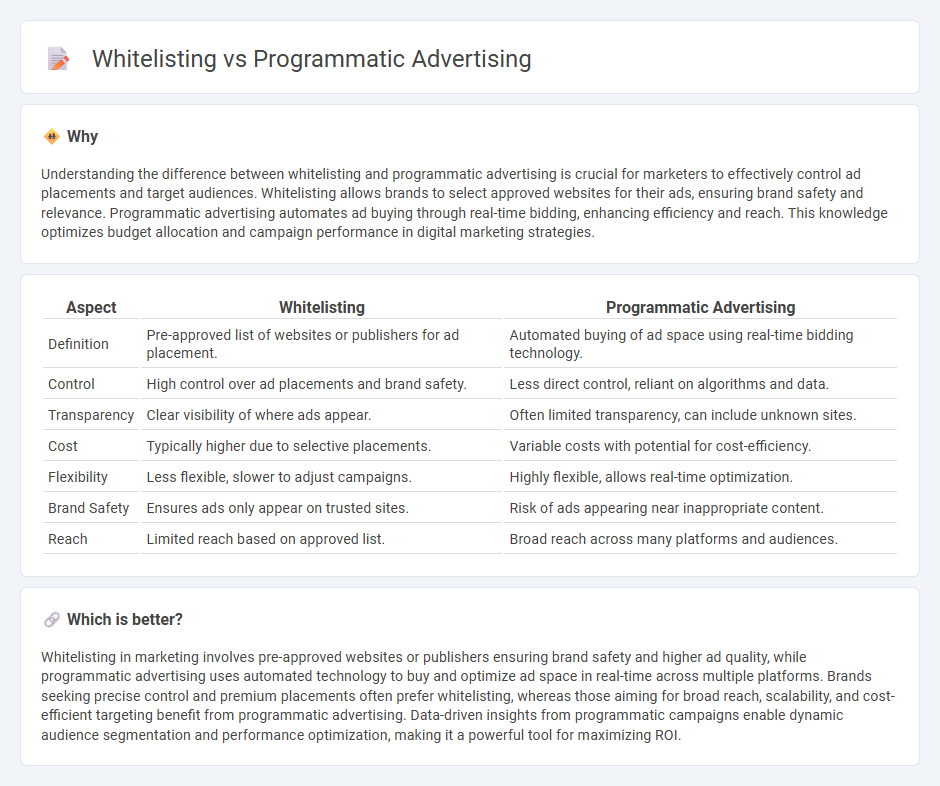
Whitelisting in marketing involves pre-approved publishers or websites that advertisers trust to display their ads, ensuring brand safety and controlled ad placement. Programmatic advertising uses automated technology and real-time bidding to target audiences across a wide range of channels and publishers, optimizing reach and efficiency. Explore deeper insights into how these strategies can impact your ad campaigns and ROI.
Why it is important
Understanding the difference between whitelisting and programmatic advertising is crucial for marketers to effectively control ad placements and target audiences. Whitelisting allows brands to select approved websites for their ads, ensuring brand safety and relevance. Programmatic advertising automates ad buying through real-time bidding, enhancing efficiency and reach. This knowledge optimizes budget allocation and campaign performance in digital marketing strategies.
Comparison Table
| Aspect | Whitelisting | Programmatic Advertising |
|---|---|---|
| Definition | Pre-approved list of websites or publishers for ad placement. | Automated buying of ad space using real-time bidding technology. |
| Control | High control over ad placements and brand safety. | Less direct control, reliant on algorithms and data. |
| Transparency | Clear visibility of where ads appear. | Often limited transparency, can include unknown sites. |
| Cost | Typically higher due to selective placements. | Variable costs with potential for cost-efficiency. |
| Flexibility | Less flexible, slower to adjust campaigns. | Highly flexible, allows real-time optimization. |
| Brand Safety | Ensures ads only appear on trusted sites. | Risk of ads appearing near inappropriate content. |
| Reach | Limited reach based on approved list. | Broad reach across many platforms and audiences. |
Which is better?
Whitelisting in marketing involves pre-approved websites or publishers ensuring brand safety and higher ad quality, while programmatic advertising uses automated technology to buy and optimize ad space in real-time across multiple platforms. Brands seeking precise control and premium placements often prefer whitelisting, whereas those aiming for broad reach, scalability, and cost-efficient targeting benefit from programmatic advertising. Data-driven insights from programmatic campaigns enable dynamic audience segmentation and performance optimization, making it a powerful tool for maximizing ROI.
Connection
Whitelisting enhances programmatic advertising by ensuring ads are only placed on approved, brand-safe websites, increasing campaign effectiveness and reducing fraud. Programmatic platforms use whitelists to automate ad buying while maintaining quality control, optimizing targeting precision and budget allocation. This connection boosts overall ROI by combining automation with trusted inventory sources.
Key Terms
**Programmatic Advertising:**
Programmatic advertising automates the buying of digital ad space using data-driven algorithms to target specific audiences in real time, enhancing campaign efficiency and precision. It leverages machine learning and big data to optimize ad placements across multiple channels, maximizing return on investment by reaching users based on behavior, demographics, and interests. Explore how programmatic advertising revolutionizes marketing strategies and drives measurable results.
Real-time Bidding
Real-time bidding (RTB) drives programmatic advertising by enabling automated auctions where advertisers bid for ad impressions in milliseconds, optimizing reach and efficiency at scale. Whitelisting restricts programmatic buying to pre-approved, trusted publishers, enhancing brand safety but potentially limiting inventory and bid competition. Explore how RTB harnesses data to balance scale and control in programmatic campaigns.
Ad Exchanges
Programmatic advertising leverages real-time bidding on ad exchanges to automate the purchase and placement of ads, maximizing reach and efficiency across multiple publishers. Whitelisting, by contrast, involves creating a list of approved ad exchanges or sites, ensuring ads appear only on trusted platforms to protect brand safety and maintain quality control. Explore detailed strategies and benefits of programmatic advertising and whitelisting on top ad exchanges to enhance your digital marketing effectiveness.
Source and External Links
Programmatic Advertising - What It Is and How It Works - Amazon Ads - Programmatic advertising automates the buying and selling of digital ads using technology and machine learning to deliver relevant ads instantly through auctions and demand-side platforms (DSPs) based on advertiser strategies and audience signals.
What Is Programmatic Advertising? How Does It Work? - Programmatic advertising leverages automated technology and algorithms to precisely target audiences by analyzing user signals, enabling efficient and strategic ad placements without manual negotiation.
Programmatic advertising - The complete guide | AppsFlyer - Programmatic advertising is an AI-driven automated process that uses various data sources to buy and sell digital ad space in real-time auctions, reducing manual efforts and optimizing revenue and targeting accuracy for advertisers and publishers.
 dowidth.com
dowidth.com